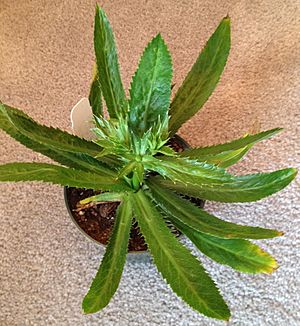Culantro facts for kids
Quick facts for kids Culantro |
|
|---|---|
 |
|
| Eryngium foetidum leaves, with a US measuring tape for scale | |
| Scientific classification | |
| Genus: |
Eryngium
|
| Species: |
foetidum
|
| Synonyms | |
|
|
Eryngium foetidum is a tropical plant that grows year after year. It's a type of herb in the carrot family, called Apiaceae. People call it by many names like culantro (say 'koo-LAHN-troh'), recao, chadon beni (say 'shadow benny'), Mexican coriander, long coriander, and sawtooth coriander.
This plant comes from places like Mexico, the Caribbean, and South America. But you can find it growing all over the world, especially in warm, tropical areas. In cooler places, it might grow for just one year.
Sometimes, people confuse culantro with cilantro. Cilantro is another herb from the same plant family. Culantro is said to taste like a stronger version of cilantro.
Contents
What is Culantro Used For?
Culantro is a very popular herb, especially in cooking. It's also been used in traditional medicine for a long time.
Cooking with Culantro
Culantro is used a lot in cooking in the Caribbean. Countries like Cuba, Puerto Rico, and Trinidad and Tobago use it. It's also a key ingredient in many dishes in Southeast Asia. This includes countries like Cambodia, Thailand, and Vietnam.
Chefs use culantro to season, marinate, and decorate food. It has a strong flavor, so a little goes a long way. Sometimes, it's used instead of cilantro leaves. Unlike cilantro, culantro dries very well. It keeps its color and flavor, which is great for dried herb products.
In the United States, culantro grows naturally in Florida, Georgia, Hawaii, and Puerto Rico.
Culantro in Traditional Medicine
For many years, people in tropical areas have used culantro in traditional medicine. They used it for different health issues. These include fevers, stomachaches, and even snake bites.
One of its old names was Eryngium antihystericum. This name shows that it was used for conditions like epilepsy. People believed the plant could calm a person's 'spirit'. This might help prevent certain kinds of fits. That's why it's also known as 'spiritweed' or 'fitweed'. Scientists have studied if this plant can help with seizures.
Studies have also shown that parts of the plant can help with pain and swelling. A chemical from the plant, called eryngial, has been studied for treating certain infections.
People have used culantro for many different problems. These include headaches, earaches, and even malaria. Scientists have found that culantro has properties that might fight germs, reduce swelling, and help with pain.
Culantro's Chemistry
Scientists have looked closely at culantro leaves. They found natural compounds like tannins and saponins. They also found some flavonoids. These are plant chemicals that can be good for you. Other compounds found include caffeic acid and chlorogenic acid.
See also
 In Spanish: Cilantro cimarrón para niños
In Spanish: Cilantro cimarrón para niños


